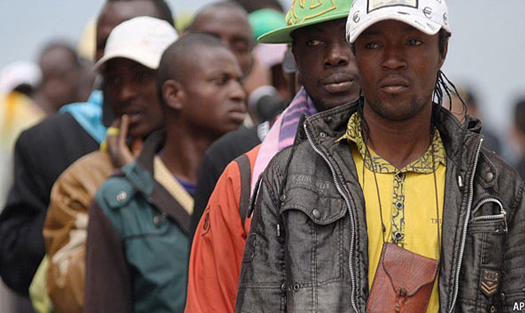
『流动劳动力不仅自己受益,如学习新技术,积累储蓄等,还给接收他们的富有国家创造劳动机会,并有可能成为这些国家未来劳动力短缺的唯一解决途径。』
The future of mobility
流动劳动力的未来
May 26th 2011 | from The Economist

American cyber-security experts failed to provide sufficient evidence when accusing Chinese cyber spies of trying to break into computers belonging to China specialists and defense contractors in the United States, a Chinese cyber expert told Xinhua on Thursday.
WHEN a Bangladeshi man goes to work on a construction site in the Middle East, his wife typically moves in with her husband’s family. Not all wives enjoy this. They sweat in a strange kitchen, take care of a bossy mother-in-law and see their husbands only for a few weeks each year. And although their husbands send home plenty of money, they often send it to their parents, not their wives. Migration creates losers as well as winners.
But the gains vastly outweigh the losses, as Ian Goldin, Geoffrey Cameron and Meera Balarajan make plain in their new book, “Exceptional People”. If rich countries were to admit enough migrants from poor countries to expand their own labour forces by a mere 3%, the world would be richer, according to one estimate, by $356 billion a year. Completely opening borders would add an astonishing $39 trillion over 25 years to the global economy. That is more than 500 times the amount the rich world spends on foreign aid each year. Migration is the most effective tool yet devised for reducing global poverty.
The same worker can earn 15 times as much if he or she moves from say, Yemen to the United States. The wage gap between rich and poor countries is far wider than it was a century ago, during the great age of migration from Europe to America. And the emotional costs of leaving home, though still hefty, are much lighter than they were. A 19th-century Russian emigrant might never see or speak to his family again. A 21st-century migrant can Skype them in the taxi from the airport.
Small wonder that the number of international migrants has doubled in the past quarter-century, to more than 200m. Increasing mobility combined with cheaper communications means that in the future, “the global community is becoming connected in a manner not experienced since our small-world evolutionary origins in Africa.” This is a fascinating point, which the authors could have pursued further than they do.
Overall, however, this is a book of bold ambitions ably fulfilled. Mr Goldin and his co-authors offer a history of migration, from man’s earliest wanderings in Africa to the present day. Thanks to modern techniques for decoding genetic evidence, far more is known today about the great movements of prehistory than was suspected even a decade ago. Genetic tests are now so cheap that Mr Goldin can draw us a map of how his own ancestors moved from east Africa 31,000 years ago, across Arabia and through Central Asia before swinging back into northern Europe.
After filling in the historical background, the authors give a rigorous but readable guide to the costs and benefits of modern migration. Poor countries may suffer when they lose their best brains to the West: 43% of Liberian doctors, for example, now work in North America. But the prospect of migrating spurs people in poor countries to acquire marketable skills. Some then decide not to migrate after all. Others spend several years abroad but then return home with new skills, new contacts and a pot of savings to invest. Overall, the brain drain actually helps poor countries. And of course, it benefits the migrants themselves. If it did not, they would not leave home.
Immigration is unpopular in rich countries because people overestimate its costs and underestimate its benefits. An influx of unskilled migrants may drag down the wages of unskilled natives, but this effect is “very small at most, and may be irrelevant”, according to a number of different studies. Migrants often create employment for natives. Indian entrepreneurs in San Francisco create new technology firms. Mexican nannies hold babies while American mothers go out to work. Migrants come when their services are wanted and stay away when they are not. Through the migrant grapevine, they know that jobs are drying up several months before government statisticians notice.
More generally, the authors predict a future of labour shortages in rich countries which only migration can solve. As Europe and America age, they will need more young and energetic nurses, care assistants, housekeepers and cleaners. Robots cannot do everything, even in Japan. The demand for highly skilled workers will grow too, and countries will start to compete more fiercely for mobile talent. Migration will “define our future”, the authors say. They are probably right. (720 words)
特别声明:①凡本网注明稿件来源为"原创"的,转载必须注明"稿件来源:育路网",违者将依法追究责任;
②部分稿件来源于网络,如有侵权,请联系我们沟通解决。
25人觉得有用
24
2011.10
『没有一种密码是100%安全的,然而有一种新的方法能使被偷的密码失效。』
新的方法能使被偷的密码失......
24
2011.10
『虽然谷歌互联网电视目前仍不被消费者和生产商们认可,但还需几年来判定这一产品是成功还是失败,目前......
24
2011.10
『网站估价远远高于其实际价值的迹象表明互联网泡沫在20世纪90年代出现后,又卷土重来了。』 The n......
24
2011.10
『他人身体上的痛苦会触发我们痛苦的感受,然而,看到他人处于某一尴尬情景,也会使我们产生类似的感受......
24
2011.10
2012年的中医综合考试大纲出来已久,通过参看其内容结构以及试卷题型结构可以看出,今年的考试大纲......
24
2011.10
试卷分布 本试卷满分300分,考试时间180分钟,总题量180道小题,分ABX三种题型。在试卷内容结构......